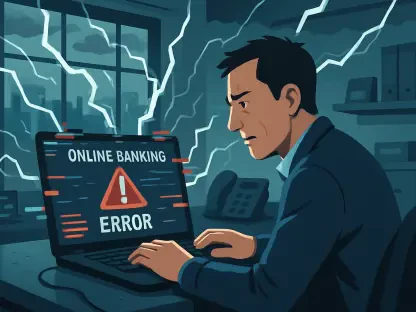As the UK rapidly progresses towards a cashless society, the shift towards digital transactions brings both convenience and substantial risk. The ubiquity of digital payments has revolutionized the banking landscape, but it has also introduced new vulnerabilities, particularly in the form of cyber threats from hostile states. These emerging dangers pose significant challenges, threatening to disrupt the financial sector and, by extension, the nation’s economy and daily life.
The Rise of Digital Payments and Associated Risks
The advent of digital payment methods has fundamentally altered how financial transactions occur within the UK. Contactless payments, online banking, and mobile transactions have become integral to daily financial activities, leading to a steep decline in the use of cash. This dependence on digital infrastructure, however, has not been without consequence. With the seamless ease of tapping a card or smartphone to complete purchases comes the heightened risk of cyberattacks targeting this infrastructure.
State-backed hackers from countries such as Russia, China, and North Korea are increasingly focusing their efforts on exploiting weaknesses in the UK’s digital payment systems. By leveraging substantial resources and sophisticated techniques, these actors can orchestrate cyberattacks capable of causing significant disruptions. The potential for a cyber event to paralyze the financial system is a looming concern, one that could bring vital services and transactions to a standstill. As digital payments become more widespread, the urgency to address and mitigate these risks grows ever more critical.
Human Weaknesses and Technology Gaps
The human element remains one of the most significant challenges in securing the UK’s banking system against cyber threats. Despite technological advancements in cybersecurity, human error continues to play a pivotal role in banking infrastructure vulnerabilities. High-profile outages, often stemming from internal malfunctions, demonstrate how fragile these systems can be. For instance, the infamous Barclays outage showed how a seemingly minor issue could escalate, potentially opening doors for more severe cyber exploits.
The complexity and legacy nature of banking IT networks exacerbate these vulnerabilities. Many banks operate on older technologies that have been integrated with modern systems, creating multiple points of potential failure. While measures like the two-man rule and system partitioning are in place to safeguard against breaches, these defenses are not perfect. Determined adversaries can still exploit both technological gaps and human weaknesses, posing a substantial threat to the sanctity of financial transactions. The necessity to upgrade and overhaul IT infrastructures is more urgent than ever to close these security loopholes.
Insider Threats and Cyber Attacks Surge
Another significant risk to banking security is the ever-present insider threat. Employees, whether coerced or bribed, can compromise critical systems through actions like inserting malicious USB sticks. These internal threats are difficult to detect and prevent, even with stringent security measures. Banks must continually innovate their defensive strategies to protect against insider threats, ensuring that significant efforts in place do not become complacent.
The last few years have shown a marked increase in cyber attacks targeting Western banks. Ransomware incidents, in particular, have surged, demonstrating the evolving nature of these threats. In a notable instance, Santander experienced a data breach, underscoring the severe repercussions these events can have. Part of this increase can be attributed to geopolitical tensions, particularly with Russia, where hackers may be retaliating against sanctions imposed on their country. These attackers, backed by artificial intelligence, are becoming more sophisticated and capable of executing more complex and damaging assaults on financial institutions.
Strategic Threats and Economic Disruptions
The potential for large-scale cyber assaults looms large, but strategic, smaller-scale attacks also present significant risks that should not be overlooked. Targeted cyber attacks might focus on particular services like cloud storage or data centers, leading to disruptions that can have systemic impacts. Such strategic moves could delay salary payments, disrupt retail operations, and severely undermine public trust in the financial system’s reliability.
The decline in cash usage further amplifies the risks associated with digital dependence. In 2023, cash transactions accounted for only 12% of all payments, with many businesses choosing not to accept physical money anymore. This trend makes the financial system increasingly reliant on digital infrastructure, which, if compromised, could leave the population unable to perform basic transactions. The risks of over-reliance on digital payments are stark and raise serious questions about the resilience and preparedness of the system in the face of potential large-scale disruptions.
Lessons and Recommendations
As the UK quickly advances towards becoming a cashless society, the transition to digital transactions offers both convenience and significant risk. The widespread adoption of digital payments has transformed the banking landscape, making financial transactions faster and easier for consumers and businesses alike. However, this shift has also introduced new weaknesses, particularly in the form of cyber threats posed by hostile states. These new dangers present major challenges, with the potential to disrupt not only the financial sector but also the broader economy and day-to-day life. Given the increasing reliance on digital financial systems, protecting against cyber threats has become more crucial than ever. Ensuring secure and resilient digital infrastructure is essential to safeguard the financial stability and continued growth of the nation in this new era. As technology advances, the balance between convenience and security will be key in maintaining trust and stability in the UK’s financial system.









